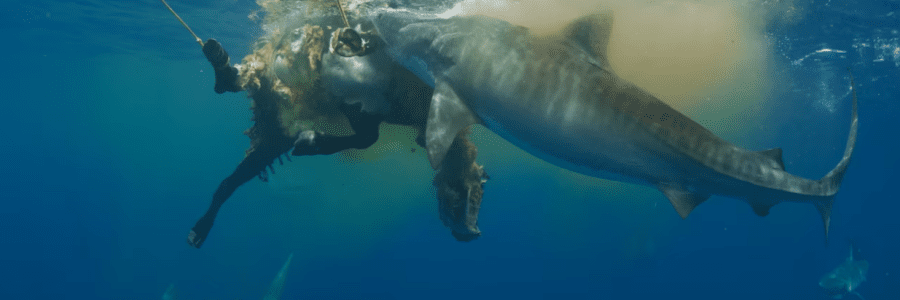A remote Pacific island is attracting supersized sharks. Scientists want to know why
Posted on: June 27th, 2024

Off Norfolk Island in the South Pacific, tiger sharks grow two feet longer than average. We’ve only started unravelling the mystery.
The water churned as two tiger sharks tore the cow carcass apart. Slowly, more of arrived to the feeding frenzy, until about 20 circled around Charlie Huveneers as he watched from inside a shark cage.
Named for their black stripes, the tiger shark is related to the great white and usually measures about nine feet. But here, in this remote pocket of the South Pacific, the fish routinely—and mysteriously—reach lengths of 15 feet.
On that day, Huveneers and Lauren Meyer, both biologists at Australia’s Flinders University, and Adam Barnett, of James Cook University, were blown away by the size of the sharks.
“This was the most tiger sharks we had ever caught in one day and they were the biggest males and biggest females we had ever seen,” says Meyer, who appears in the Nat Geo SharkFest episode Supersized Sharks.
Over the next few days, the team caught 20 more sharks, which they studied and measured. “It exceeded all of our expectations,” she says.
Watch a trailer for Shark Beach with Anthony Mackie: Gulf Coast, which kicks off SharkFest on June 30.
The scientists were in Norfolk Island to study why the remote island attracts so many tiger sharks, the highest known concentration of the species in the world. Their mission was also crucial for conservation: These ocean mammoths are near threatened with extinction, due mostly to overfishing.(Read about the surprising ways sharks keep oceans healthy.)
A territory of Australia, Norfolk Island is a former penal colony with a long history of cattle ranching. Because there’s no good way to dispose of dead livestock without poisoning the groundwater, ranchers often dump the offal directly into the ocean.
SharkFest kicks off June 30 with the show Shark Beach with Anthony Mackie: Gulf Coast at 9/8c followed by Shark Vs. Ross Edgley at 10/9c on Nat Geo. All SharkFest programming, including Supersized Sharks, streams on Disney+ and Hulu July 1.
At first, the team thought these supersized sharks might be sticking around the island to take advantage of this “drive-through hamburger joint,” as Meyer says.
But what they found was even more mysterious.

Fast food—of the sea
The researchers started digging into the sharks’ diet to see if the cow carcasses were keeping them around. “You need something special to be able to sustain that many large sharks,” says Huveneers.
Stable isotope analysis—analyzing atoms of various elements to see what the animals were eating—revealed a surprise: Only 10 percent of the sharks’ diet was made up of cow. “That’s a tiny amount compared to what we expected,” says Huveneers.
That made it was clear the fish had another key food source: “This huge population of large tiger sharks will need a lot more to eat than the occasional bit of leftover cow,” says Meyer. (See gorgeous pictures of sharks.)
So, what were they eating? The analysis revealed that the island is more of a chicken restaurant than a burger joint—52 percent of the sharks’ diet was made up of seabirds. As it turns out, “the offal was just a bit of dessert for them,” she says.
Scientists already knew that tiger sharks eat birds, but the researchers were so surprised by the amount in the Norfolk shark diet that they had to double check their data.

Rafting seabirds
The wedgetail shearwater flocks to Norfolk Island in the tens of thousands to nest.
At dusk, these seabirds float on the surface of the water in large “rafts,” making them easy prey. “It would be very difficult for the birds to detect a predator coming up from underneath, especially at this time of day,” says Meyer.
Large tiger sharks are rather slow and opportunistic hunters, relying primarily on the element of surprise. “That seabird rafting behavior at dusk is the perfect opportunity for sharks to come up and use their big, flat noses to suction these birds off the surface.”
Sophia Emmons, a Ph.D. student at James Cook University and University of South Florida, agrees seabirds are a perfect meal.
Though tiger sharks are “built like they’re going to be the most apex predator—they have the streamlined body shape, incredible jaw strength, and they’re able to bite through turtle shells … they’re so lazy,” says Emmons, who wasn’t involved in the research. (Related: “Do tiger sharks or hammerheads have stronger bites?”)
Which has a stronger bite: hammerheads or tiger sharks?
Sometimes known as the “trash cans of the sea,” these scavengers have been found with farm animals, license plates, and even a suit of armor in their stomachs.
With such a plentiful supply of seabirds to snack on, it makes sense to Emmons that Norfolk Island’s tiger sharks grow much larger than other populations.
“With a very good food source, whether it’s primarily from the cattle or from the seabirds, tiger sharks can expend more energy and put more of that into growth,” she says.
Emmons also wonders if there’s a secondary connection between the cattle and sharks. “Do the cattle bring in fish, the fish bring in birds, and the birds bring in the sharks?” she says.
Huveneers and the team think that’s unlikely, in part because the sharks aren’t staying at Norfolk Island year-round.

Fair-weather friends
In another unexpected development, the team found these tiger sharks only stay near Norfolk Island for five months over the spring and summer. “That’s surprising, considering there could be enough food for them throughout the year,” says Huveneers.
Tagged animals have revealed many of Norfolk Island’s tiger sharks migrate 600 miles to New Caledonia, a French territory, in the autumn. But although there was a consistent pattern with sharks migrating between Norfolk Island and New Caledonia, their routes varied wildly. (See the biggest shark discoveries of the past decade.)
“We had some going to Australia, Fiji, Vanuatu, nearly to New Zealand, and Papua New Guinea,” says Huveneers.
Now, the scientists know where these massive sharks are going, they want to figure out why. One theory is that the sharks mate near Norfolk Island and give birth in the waters of New Caledonia, which is in the open ocean, far from many predators.
about:blank

SHARKS 101Sharks can rouse fear and awe like no other creature in the sea. Find out about the world’s biggest and fastest sharks, how sharks reproduce, and how some species are at risk of extinction.
“Newborn tiger sharks are really quite vulnerable,” says Meyer, “so pups need to be dropped off at the most suitable locations to maximize their chance of survival.”
Searching for a nursery
If Norfolk Island is a breeding ground, female sharks could be fattening up on seabirds before dropping their pups in New Caledonia’s warm tropical waters.
However, none of the ultrasounds the team performed on Norfolk Island sharks revealed pups. Likewise, these females did not bear mating scars.
Though the team did identify one pregnant female in New Caledonia—“we could actually feel pups in the belly,” says Meyer—a nursery remained elusive.
If future research identifies nursery grounds, these areas could be protected—a vital step for protecting the declining species.
For now, the mystery of why these immense sharks are drawn to Norfolk Island and New Caledonia remains unsolved, says Huveneers: “We’re getting closer to the answer, but it’s certainly not a slam dunk.”


